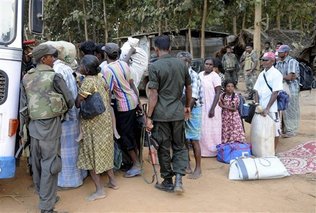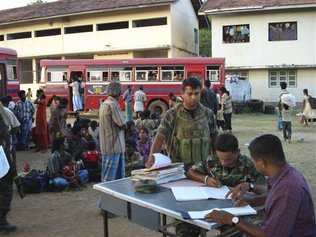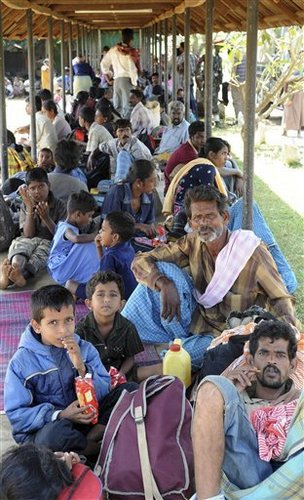Ilankai Tamil Sangam29th Year on the Web Association of Tamils of Sri Lanka in the USA |
|||||||||
 Home Home Archives Archives |
Sri Lanka Plans to House War Refugees for 3 Yearsby Ravi Nessman, Associated Press, February 11, 2009
COLOMBO, Sri Lanka Sri Lanka is preparing to house 200,000 civil war refugees at five huge "welfare villages" - complete with post offices, banks and libraries - where it expects them to stay for up to three years, according to a government plan.
The draft plan, which the government has circulated among international aid groups and donors in recent days, surfaced as tens of thousands of civilians fled the northern battlefield where Tamil Tiger rebels and government forces have been waging heavy battles. The government's preparations appear to lend support to Red Cross estimates last month that 250,000 civilians were trapped in the war zone. The government says the number is less than half that, giving a much less dire assessment of the potential humanitarian crisis. Aid workers and Western diplomats have expressed concerns about the treatment of the ethnic Tamil civilians in the camps and are worried the proposed plan would keep the displaced from returning to their homes while the military spends years searching the jungles and villages for the last remnants of the Tamil rebels. The rebels have been fighting since 1983 for an independent state in the north for minority Tamils marginalized for decades by governments dominated by the Sinhalese majority. In recent months, the military has swept the rebels out of much of their 5,600-square-mile de facto state in the north and boxed them into a 58-square-mile strip of coastal land in the northeast where they hope to crush the group. The draft proposal estimates 40,000 to 50,000 internally displaced families totaling more than 200,000 people would flee the war zone. The "welfare villages" would be set up to house them for two to three years, the report said.
The Associated Press obtained copies of the document separately from two aid groups and a Western diplomat. After being searched for weapons, the war refugees are being taken to 15 temporary transit camps located in schools and other buildings just south of the de facto state the rebels once ruled in a region known as the Vanni. The government initially barred aid workers from the transit camps without explanation but has given them far more access in recent days as the need for international assistance grew. The government eventually plans to move all the civilians into five more permanent camps south of the war zone. Rights groups and analysts have raised a number of concerns over the plan. Paikiasothy Saravanamuttu, executive director of the Center for Policy Alternatives think tank said a long stay in displacement camps could frustrate the displaced, exacerbate ethnic tensions and "lead to a strong reinforcement of Tamil nationalism." In December, Human Rights Watch criticized the government's treatment of the fleeing civilians, saying it was arbitrarily detaining them in camps that were little better than prisons. In meetings with government officials over the new proposals, international aid groups raised concerns that the camps will be run by the military and residents will not be allowed to leave, according to an aid official who took part in one of the meetings. The official spoke on condition of anonymity for fear of losing access to the camps. The government played down many of those concerns, however, and said the camps would keep civilians safe. Rajiva Wijesinha, secretary at the Ministry of Disaster Management and Human Rights, said the camps would be run by the government but the military would have "great involvement." "There is a very clear security threat and we are not going to play games with the lives of our people," he said. Mahinda Samarasinghe, minister of disaster management and human rights, told journalists Tuesday that the camps will not be detention centers but will provide residents with education and vocational training. "I am quite sure those who are there are at least happy to be there because they are out of a dangerous environment," he said. Aid groups have demanded full access to the camps and said they would only make a three-month - not a three-year - commitment, according to the aid official. Diplomats and aid workers also expressed concerns about the lack of monitors at the areas where the civilians are initially screened when they cross into government territory to ensure everyone is registered and treated properly.
The plan is for a "worst-case scenario," said Wijesinha. The government does not believe the number of displaced will be as large as stated in the proposal and hopes to resettle the civilians far faster than two to three years, he said. However, the population would have to stay out of the Vanni for some time so troops could clear mines and finish fighting the rebels, known formally as the Liberation Tigers of Tamil Eelam, he said. "There's going to be little pockets of LTTE for a little bit longer. With those security considerations taken together, it's going to be a little bit slower" to resettle the civilians, he said. The government proposal calls for creating four villages, totaling nearly 1,000 acres, in the Vavuniya district and a fifth 100-acre camp in the neighboring Mannar area. The villages would have 39,000 semi-permanent homes, 7,800 toilets and 780 septic tanks, as well as parks, post offices, banks, stores and about 390 community centers with televisions and radios, according to the plan. One agency chief familiar with the plan said it would be very expensive. Not only would the government and aid groups have to feed, clothe and house the residents, but since most of the civilians are farmers, the economy would suffer as their fields lay fallow. A second proposal called for the construction of 40 schools to hold an expected 86,171 students. That plan asked international donors to fund everything from a photocopying machine for each school to instruments for the school band, at a total cost of about $14 million.
| ||||||||


